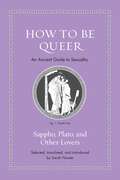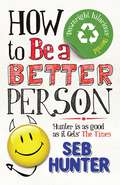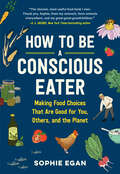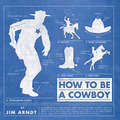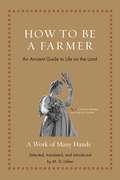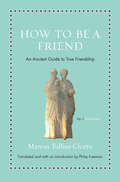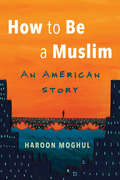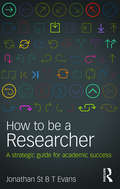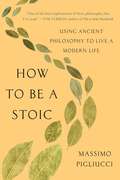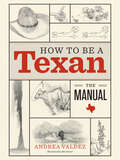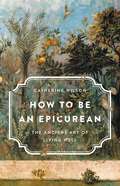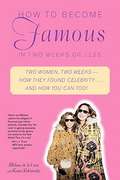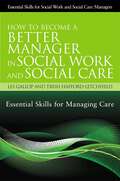- Table View
- List View
How to Be Old: Lessons in Living Boldly from the Accidental Icon
by Lyn SlaterOne of Elle's Most Anticipated Nonfiction Books of 2024A personal memoir in which Lyn Slater, known on Instagram as &“Accidental Icon,&” brings her characteristic style, optimism, forward-thinking, and rules-are-meant-to-be-broken attitude to the question of how to live boldly at any age. When Lyn Slater started her fashion blog, Accidental Icon, at age sixty-one, she discovered that followers were flocking to her account for more than just her A-list style. As Lyn flaunted gray hair, wrinkles, and a megadose of self-acceptance, they found in her an alternative model of older life: someone who defied the stereotypes, refused to become invisible, and showed that all women have the opportunity to be relevant and take major risks at any stage of their life. Youth is not the only time we can be experimental. How to Be Old tells the ten-year story of Lyn&’s sixties, the sometimes-glamorous, sometimes-turbulent decade of Accidental Icon. This memoir is about the hopeful and future-oriented process of reinvention. It shows readers that while you can&’t control everything, what you can control is the way you think about your age and the creative ways you respond to the changes in your mind and body as they happen. Rather than trying to meet standards of youth and beauty as a measure of successful aging, Lyn promotes a more inclusive and empowering standard to judge our older selves by. In this paradigm-shifting memoir, Lyn exemplifies that even with its unique challenges, being old is just like any new beginning in your life and can be the best and most invigorating of all of life&’s phases, full of rebellion and reinvention, connection and creativity.
How to Be Queer: An Ancient Guide to Sexuality (Ancient Wisdom for Modern Readers)
by Sarah NooterAn irresistible anthology of ancient Greek writings that explore queer desire and loveEros, limb-loosening, whirls me about again,that bittersweet, implacable creature.—SapphoThe idea of sexual fluidity may seem new, but it is at least as old as the ancient Greeks, who wrote about queer experiences with remarkable frankness, wit, and insight. How to Be Queer is an infatuating collection of these writings about desire, love, and lust between men, between women, and between humans and gods, in lucid and lively new translations. Filled with enthralling stories, this anthology invites readers of all sexualities and identities to explore writings that describe many kinds of erotic encounters and feelings, and that envision a playful and passionate approach to sexuality as part of a rich and fulfilling life.How to Be Queer starts with Homer&’s Iliad and moves through lyric poetry, tragedy, comedy, philosophy, and biography, drawing on a wide range of authors, including Sappho, Plato, Anacreon, Pindar, Theognis, Aristophanes, and Xenophon. It features both beautiful poetry and thought-provoking prose, emotional outpourings and humorous anecdotes. From Homer&’s story of the relationship between Achilles and Patroclus, one of the most intense between men in world literature, to Sappho&’s lyrics on the pleasures and pains of loving women, these writings show the many meanings of what the Greeks called eros.Complete with brief introductions to the selections, and with the original Greek on facing pages, How to Be Queer reveals what the Greeks knew long ago—that the erotic and queer are a source of life and a cause for celebration.
How to Be a Better Person
by Seb HunterWhy is it so difficult to find the time to help others? When Seb Hunter became aware of a nagging ache in the place where his soul ought to be, he embarked on a two year odyssey of volunteering – with hilarious results. He collects litter, teaches pensioners how to use the internet, works at Oxfam (where he meets Gladys, his septuagenarian nemesis), mans a steam train line, becomes a star DJ on hospital radio, visits prisoners, and runs a very long way for charity... But will his quest for self-improvement be successful? How to Be a Better Person is the tale of a cynic's attempt to become a better person by helping others. For nothing. It's a volunteering call-to-arms! Oh no it's not! Well it is, sort of...
How to Be a Billionaire: Proven Strategies from the Titans of Wealth
by Martin S. FridsonA comprehensive picture of the real strategies and tactics that built the great business fortunes of modern times. Packed with engaging accounts of titans, How to Be a Billionaire will show you principles that can increase your wealth and business acumen.
How to Be a Conscious Eater: Making Food Choices That Are Good for You, Others, and the Planet
by Sophie EganA radically practical guide to making food choices that are good for you, others, and the planet. Is organic really worth it? Are eggs ok to eat? If so, which ones are best for you, and for the chicken—Cage-Free, Free-Range, Pasture-Raised? What about farmed salmon, soy milk, sugar, gluten, fermented foods, coconut oil, almonds? Thumbs-up, thumbs-down, or somewhere in between? Using three criteria—Is it good for me? Is it good for others? Is it good for the planet?—Sophie Egan helps us navigate the bewildering world of food so that we can all become conscious eaters. To eat consciously is not about diets, fads, or hard-and-fast rules. It&’s about having straightforward, accurate information to make smart, thoughtful choices amid the chaos of conflicting news and marketing hype. An expert on food&’s impact on human and environmental health, Egan organizes the book into four categories—stuff that comes from the ground, stuff that comes from animals, stuff that comes from factories, and stuff that&’s made in restaurant kitchens. This practical guide offers bottom-line answers to your most top-of-mind questions about what to eat. &“The clearest, most useful food book I own.&”—A. J. Jacobs, New York Times bestselling author
How to Be a Cowboy
by Jim ArndtExplore every facet of being a cowboy with essays and colorful photos in this guide from the author of Buckaroo Boots and Art of the Buckle.How to be a Cowboy is a compendium of knowledge and insight, wit and wisdom, and all-around resource for every aspect of cowboy life. It includes the least you need to know about ranching, rodeoing, cooking, music, dancing, yodeling, lingo (like &“dude,&” &“bronc,&” and &“hoss&”), cowboy poetry, hats, boots (like boot history and how to choose a pair for yourself), spurs, shirts, horses, hats, buckles, denim, and also how to walk like a cowboy. Discover the top twenty cowboy movies and top western novels. You&’ll even find advice from cowboy icon Will Rogers.&“It&’s the rich color camerawork that really compels, and Arndt&’s classy shots of elaborately designed boots, shirts, blue jeans and hats, plus peripheral cowboy gear, are enough to make a guy chuck the 9-to-5 and head out to the wild, wild West.&”—Martin Brady, BookPage
How to Be a Farmer: An Ancient Guide to Life on the Land (Ancient Wisdom for Modern Readers)
by M. D. Usher Mark UsherA delightful anthology of classical Greek and Roman writings celebrating country living—ranging from a philosophy of compost to hymns to the gods of agricultureWhether you farm or garden, live in the country or long to move there, or simply enjoy an occasional rural retreat, you will be delighted by this cornucopia of writings about living and working on the land, harvested from the fertile fields of ancient Greek and Roman literature. An inspiring antidote to the digital age, How to Be a Farmer evokes the beauty and bounty of nature with a rich mixture of philosophy, practical advice, history, and humor. Together, these timeless reflections on what the Greeks called boukolika and the Romans res rusticae provide an entertaining and enlightening guide to a more meaningful and sustainable way of life.In fresh translations by classicist and farmer M. D. Usher, with the original texts on facing pages, Hesiod praises the dignity of labor; Plato describes the rustic simplicity of his ideal republic; Varro dedicates a farming manual to his wife, Fundania (“Mrs. Farmer”); and Vergil idealizes farmers as residents of the Golden Age. In other selections, Horace extols the joys of simple living at his cherished country farm; Pliny the Elder explains why all culture stems from agriculture; Columella praises donkeys and tells how to choose a ram or a dog; Musonius Rufus argues that farming is the best livelihood for a philosopher; and there is much more.Proof that farming is ultimately a state of mind we should all cultivate, How to Be a Farmer will charm anyone who loves nature or its fruits.
How to Be a Fascist: A Manual
by Michela MurgiaThe first and only guide to turning your 21st century democracy into a fascist paradise.Democracy is difficult, flawed and unstable. It involves barely distinguishable political parties taking part in lengthy, overcomplicated and expensive decision-making processes. Trying to engage so many people with political issues seems to lead only to complexity and disagreement. So why bother? Doesn't fascism guarantee a more effective and efficient management of the state?In this short, bitingly ironic mixture of On Tyranny and The Psychopath Test, Italian political activist Michela Murgia explores the logic that is attracting increasing numbers of voters to right-wing populism. Far from its origins in the 20th century, fascism is once again on the rise in an age of increased connectivity and globalism. Murgia shows how many of the elements of our society that we might think would combat closed-mindedness and xenophobia actually fan the flames. Closing with a "fascistometer" to measure the reader's own authoritarian inclinations, How to be a Fascist is a refreshingly direct, polemical book that asks us to confront the fascisim in our governments, in our societies, and in our own political leanings.
How to Be a Friend: An Ancient Guide to True Friendship (Ancient Wisdom for Modern Readers)
by Marcus Tullius Cicero Philip FreemanA splendid new translation of one of the greatest books on friendship ever writtenIn a world where social media, online relationships, and relentless self-absorption threaten the very idea of deep and lasting friendships, the search for true friends is more important than ever. In this short book, which is one of the greatest ever written on the subject, the famous Roman politician and philosopher Cicero offers a compelling guide to finding, keeping, and appreciating friends. With wit and wisdom, Cicero shows us not only how to build friendships but also why they must be a key part of our lives. For, as Cicero says, life without friends is not worth living.Filled with timeless advice and insights, Cicero’s heartfelt and moving classic—written in 44 BC and originally titled De Amicitia—has inspired readers for more than two thousand years, from St. Augustine and Dante to Thomas Jefferson and John Adams. Presented here in a lively new translation with the original Latin on facing pages and an inviting introduction, How to Be a Friend explores how to choose the right friends, how to avoid the pitfalls of friendship, and how to live with friends in good times and bad. Cicero also praises what he sees as the deepest kind of friendship—one in which two people find in each other “another self” or a kindred soul.An honest and eloquent guide to finding and treasuring true friends, How to Be a Friend speaks as powerfully today as when it was first written.
How to Be a Good Girl: A Miscellany
by Jamie HoodThe ambitious and experimental debut by Jamie Hood, author of Trauma Plot, interrogating the &“good girl&” archetype and the price one pays to embody itIn the thick of winter 2020, when so many books were buried beneath the catastrophe of the COVID-19 news cycle, one unlikely debut seemed to cut through the noise. Jamie Hood&’s How to Be a Good Girl was an inventive and hybrid work of self-making, mingling diary entries, poetry, literary criticism, and love letters to interrogate the archetype of the &“good girl,&” and the ideas of femininity, passivity, desire, and trauma that come with it. Journeying from the ice age to our modern-day climate crisis, it devoured texts as expansive as Levinas and Plath to the Ronettes and after-school specials, all the while asking: what pound of flesh must a woman pay to be seen as &“good.&”How to Be a Good Girl was a critical darling when it was first published by Grieveland. The Rumpus praised its &“bold vulnerability,&” and Vogue named it a Best Book of 2020. Now, Vintage is proud to reissue this provocative and genre-bending debut and find new readers for an exciting, new literary voice.
How to Be a Muslim: An American Story
by Haroon MoghulA young Muslim leader’s memoir of his struggles to forge an American Muslim identityHaroon Moghul was thrust into the spotlight after 9/11, becoming an undergraduate leader at New York University’s Islamic Center forced into appearances everywhere: on TV, before interfaith audiences, in print. Moghul was becoming a prominent voice for American Muslims even as he struggled with his relationship to Islam. In high school he was barely a believer and entirely convinced he was going to hell. He sometimes drank. He didn’t pray regularly. All he wanted was a girlfriend.But as he discovered, it wasn’t so easy to leave religion behind. To be true to himself, he needed to forge a unique American Muslim identity that reflected his beliefs and personality. How to Be a Muslim reveals a young man coping with the crushing pressure of a world that fears Muslims, struggling with his faith and searching for intellectual forebears, and suffering the onset of bipolar disorder. This is the story of the second-generation immigrant, of what it’s like to lose yourself between cultures and how to pick up the pieces.
How to Be a Researcher: A strategic guide for academic success
by Jonathan St EvansHow to be a Researcher provides a strategic guide to the conduct of a successful research career within a university environment. Based on the author’s extensive personal experience, it offers down-to-earth advice, philosophical guidance, and discussions of the political context of academic research. This is not a research methods book, and the topics it covers are rarely discussed elsewhere. The bulk of the book provides practical advice on the development of essential skills and strategic approaches, covering questions such as: how to decide which topics to work on how to read and review literature how to develop theory how to integrate research and teaching activity how to approach research design how to obtain and manage research funding how to collaborate and supervise effectively how to write up your research, and how to secure the best sources of publication. The final part of the book considers the philosophy and psychology of research work and includes an exploration of the cognitive biases which may affect researchers. How to be a Researcher will be particularly useful for masters and doctoral students in the behavioral and social sciences, and also for early career academics developing research within a university career.
How to Be a Social Justice Advocate: Create Positive Change in Your Home, Community, and World
by A. Rahema MooltreyTake action to promote social justice with help from this practical guideSocial justice is about uplifting and empowering underserved and marginalized communities impacted by systems of oppression. While believing in equity and fairness is easy, taking action and doing your part requires work. This book is filled with practical, real-world advice that shows you how to serve and support your community through activism. You'll discover concrete steps you can take in 4 key areas that determine well-being and livelihood for all groups of people: education, economic stability, health, and safety.This standout among social justice books encourages you to:Get involved—Examine your intentions and unconscious biases, take stock of your strengths and interests, and consider important historical contexts when involving yourself in social justice work.See justice in action—Read relatable stories about real-life social justice wins to help inspire your own activism.Engage with others—Social justice is only possible when in community with others. Find tips on involving friends, family, and other community members in respectful and sustainable ways.Promote social justice and help create meaningful change with How to Be a Social Justice Advocate.
How to Be a Stoic: Using Ancient Philosophy to Live a Modern Life
by Massimo PigliucciAn engaging guide to how Stoicism--the ancient philosophy of Epictetus and Marcus Aurelius--can provide lessons for living in the modern worldWhenever we worry about what to eat, how to love, or simply how to be happy, we are worrying about how to lead a good life. No goal is more elusive. In How to Be a Stoic, philosopher Massimo Pigliucci offers Stoicism, the ancient philosophy that inspired the great emperor Marcus Aurelius, as the best way to attain it. Stoicism is a pragmatic philosophy that teaches us to act depending on what is within our control and separate things worth getting upset about from those that are not. By understanding Stoicism, we can learn to answer crucial questions: Should we get married or divorced? How should we bank in a world nearly destroyed by a financial crisis? How can we survive great personal tragedy? Whoever you are, Stoicism has something for you-and How to Be a Stoic is your essential guide.
How to Be a Texan: The Manual
by Andrea ValdezThere are certain things every Texan should know how to do and say, whether your Lone Star roots reach all the way back to the 1836 Republic or you were just transplanted here yesterday. Some of these may be second nature to you, but others . . . well, maybe it wouldn’t hurt to have a few handy hints if, say, branding the herd or hosting a tamalada aren’t your usual pastimes. That’s where How to Be a Texan can help. In a friendly, lighthearted style, Andrea Valdez offers illustrated, easy-to-follow steps for dozens of authentic Texas activities and sayings. In no time, you’ll be talking like a Texan and dressing the part; hunting, fishing, and ranching; cooking your favorite Texas dishes; and dancing cumbia and two-step. You’ll learn how to take a proper bluebonnet photo and build a Día de los Muertos altar, and you’ll have a bucket list of all the places Texans should visit in their lifetime. Not only will you know how to do all these things, you’ll finish the book with a whole new appreciation for what it means to be a Texan and even more pride in saying “I’m from Texas” anywhere you wander in the world.
How to Be an Anticapitalist in the Twenty-First Century
by Erik Olin WrightWhat is wrong with capitalism, and how can we change it?Capitalism has transformed the world and increased our productivity, but at the cost of enormous human suffering. Our shared values—equality and fairness, democracy and freedom, community and solidarity—can provide both the basis for a critique of capitalism and help to guide us toward a socialist and democratic society. Erik Olin Wright has distilled decades of work into this concise and tightly argued manifesto: analyzing the varieties of anticapitalism, assessing different strategic approaches, and laying the foundations for a society dedicated to human flourishing. How to Be an Anticapitalist in the Twenty-First Century is an urgent and powerful argument for socialism, and an unparalleled guide to help us get there. Another world is possible. Included is an afterword by the author’s close friend and collaborator Michael Burawoy.
How to Be an Antiracist
by Ibram KendiFrom the National Book Award–winning author of Stamped from the Beginning comes a “groundbreaking” (Time) approach to understanding and uprooting racism and inequality in our society—and in ourselves. “The only way to undo racism is to consistently identify and describe it—and then dismantle it.” <P><P>Antiracism is a transformative concept that reorients and reenergizes the conversation about racism—and, even more fundamentally, points us toward liberating new ways of thinking about ourselves and each other. <P><P> At it's core, racism is a powerful system that creates false hierarchies of human value; its warped logic extends beyond race, from the way we regard people of different ethnicities or skin colors to the way we treat people of different sexes, gender identities, and body types. <P><P> Racism intersects with class and culture and geography and even changes the way we see and value ourselves. In How to Be an Antiracist, Kendi takes readers through a widening circle of antiracist ideas—from the most basic concepts to visionary possibilites—that will help readers see all forms of racism clearly, understand their posionous consequences, and work to oppose them in our systems and in ourselves. <P><P>Kendi weaves an electrifying combination of ethics, history, law, and science with his own personal story of awakening to antiracism. This is an essential work for anyone who wants to go beyond the awareness of racism to the next step: contributing to the formation of a just and equitable society. <P><P><b> A New York Times Bestseller </b>
How to Be an Epicurean: The Ancient Art of Living Well
by Catherine WilsonA leading philosopher shows that if the pursuit of happiness is the question, Epicureanism is the answer Epicureanism has a reputation problem, bringing to mind gluttons with gout or an admonition to eat, drink, and be merry. In How to Be an Epicurean, philosopher Catherine Wilson shows that Epicureanism isn't an excuse for having a good time: it's a means to live a good life. Although modern conveniences and scientific progress have significantly improved our quality of life, many of the problems faced by ancient Greeks -- love, money, family, politics -- remain with us in new forms. To overcome these obstacles, the Epicureans adopted a philosophy that promoted reason, respect for the natural world, and reverence for our fellow humans. By applying this ancient wisdom to a range of modern problems, from self-care routines and romantic entanglements to issues of public policy and social justice, Wilson shows us how we can all fill our lives with purpose and pleasure.
How to Be an Inclusive Leader: Your Role in Creating Cultures of Belonging Where Everyone Can Thrive
by Jennifer BrownWe know why diversity is important, but how do we drive real change at work? Diversity and inclusion expert Jennifer Brown provides a step-by-step guide for the personal and emotional journey we must undertake to create an inclusive workplace where everyone can thrive. Human potential is unleashed when we feel like we belong. That's why inclusive workplaces experience higher engagement, performance, and profits. But the reality is that many people still feel unable to bring their true selves to work. In a world where the talent pool is becoming increasingly diverse, it's more important than ever for leaders to truly understand how to support inclusion.Drawing on years of work with many leading organizations, Jennifer Brown shows what leaders at any level can do to spark real change. She guides readers through the Inclusive Leader Continuum, a set of four developmental stages: unaware, aware, active, and advocate. Brown describes the hallmarks of each stage, the behaviors and mind-sets that inform it, and what readers can do to keep progressing. Whether you're a powerful CEO or a new employee without direct reports, there are actions you can take that can drastically change the day-to-day reality for your colleagues and the trajectory of your organization.Anyone can—and should—be an inclusive leader. Brown lays out simple steps to help you understand your role, boost your self-awareness, take action, and become a better version of yourself in the process. This book will meet you where you are and provide a road map to create a workplace of greater mutual understanding where everyone's talents can shine.
How to Become Famous in Two Weeks or Less
by Melissa de la Cruz Karen Robinovitz2 WOMEN, 14 DAYS. THE GOAL? ACHIEVE BOLD FACE STATUS SIGHTINGS: Spotted last night at a giant bash at Nobu: fashionista cuties Karen Robinovitz and Melissa De La Cruz. Karen was heard saying she’s “still exhausted” from her recent Bungalow 8 birthday party that would have made P. Diddy jealous. Apparently, she was wearing two million dollars’ worth of Harry Winston diamonds (including the 22-carat ring Whoopie Goldberg wore to the Oscars) and was constantly shadowed by a bodyguard named Lou who was straight out of a Scorsese film. Melissa, also fatigued from the fast track, just hosted an intimate dinner party at a swanky Upper East Side restaurant attended by trend-setting journos from New York magazine, The Observer, Allure, “Page Six” as well as the indefatigable Michael Musto–and as part of the gift bag giveaway, the whole crew is being flown to Miami to stay at a five-star resort favored by the likes of Will Smith. Asked how they managed to go from barely-known freelance writers to A-list celebrities in just fourteen days, they coyly spilled the beans: Marie Claire called with the assignment, and they simply begged, clawed, cried, borrowed, cheated, lied, stole, and bribed their way to fame. Their how-to tips to stardom include “Pick an M&M color to hate, and stick to it. ” And they’re writing a book, daaahlings, so whether you live in New York or Nebraska, you too can have the goods to claim your own fame and become legendary. From the Trade Paperback edition.
How to Become a Better Manager in Social Work and Social Care: Essential Skills for Managing Care
by Trish Hafford-Letchfield Les GallopSocial work and social care managers often find themselves in management positions without having had any formal management training, yet skills and knowledge specific to social care settings are essential for effective practice. This book offers a researched and practical guide to the fundamental skills and knowledge that a manager needs, underpinned by the values and ethics that are inherent to social work and social care. Core skills covered include time management, recruitment, managing meetings, working in partnership with service users, negotiation and conflict management, and mentoring and coaching. A self-improvement feedback assessment is included, and the book features learning activities, practical tools, case examples, summaries and action checklists. This must-have handbook will help social work and social care managers and students to understand and accomplish the core skills needed for excellent management practice.
How to Become a Big Man in Africa: Subalternity, Elites, and Ethnic Politics in Contemporary Nigeria
by Wale AdebanwiCan subalterns transform themselves into members of the elite, and what does it take to do so? And how do those efforts reveal the nature of ethnic politics in postcolonial Africa? How to Become a Big Man in Africa: Subalternity, Elites, and Ethnic Politics in Contemporary Nigeria examines these questions by revealing how, through ethno-regional conflict, violence and cultural activities, an artisan, Gani Adams, transformed himself into the holder of the most prestigious chieftaincy title among the Yoruba. Addressing persistent gaps in anthropological studies of the subaltern and of "big men" in politics through in-depth biography and rich social history, Wale Adebanwi follows Adams and other major figures in Nigeria's Oodua People's Congress (OPC) over two decades of ethnographic study and visual representations. Challenging existing models of African political mobility by leveraging his initial lack of formal education into a position of power, Adams moved from a "radical lumpen" and "area boy" to a "big man" who continues to struggle—and reflect—over the significance of his role as a cultural subject. Blurring the lines between tradition and modernity, Adams and his group have used Yoruba rituals to simultaneously claim authenticity and champion new movements for democracy and self-determination.How to Become a Big Man in Africa encourages us to understand the full complexity of Adams's political trajectory and how it reflects the structural and personal realities of becoming a "Big Man" in the contemporary postcolony.
How to Become a Modern Magus: A Manual for Magicians of All Schools
by Don WebbA detailed step-by-step program for building a magical practice• Offers a full 12 months of activities, rituals, spells, and exercises to help you acquire magical skills and knowledge and achieve your goals• Details the practice of Egyptian Soul Craft, including how to work with the KA and the BA and how to perform magical workings with Egyptian deities• Shares spells for specific purposes, from manifesting wealth to summoning lost things to healing ailments, as well as providing templates to create your own rituals and custom spellsIn this practical training guide, Don Webb lays out a detailed step-by-step program for building and sustaining a magical practice. Based not on Eliphas Levi&’s correspondence system but on an older form of Egyptian magic, as well as drawing on Chaos Magic, shamanism, and the secret techniques of the Temple of Set, the program offers a full 12 months of activities, rituals, spells, and exercises to help you acquire magical skills and knowledge and maximize your strengths over the course of a year. Beginning with the hows and whys of magic, as well as the real dangers of the occult and how to avoid or cure them, the author shares experiences from his 45 years of personal work and 30 years of teaching the magical arts. He presents the Inshallo Rite for creating a magical helper as the first step on the road to becoming a magician. Presenting a chapter-per-month curriculum, he explores the magical powers of elements, gods, and esoteric traditions, with weekly and daily exercises as well as emotional and mental training connected to each month&’s topic. He examines the four elements in depth, sharing rites, invocations, spells, and activities for working magically with each element. Based on more than three decades of magical teaching, Don Webb&’s guide to becoming a modern magus will help beginners start their magical journey and support experienced magicians to revitalize and balance their existing practice.
How to Become a Scandal: Adventures in Bad Behavior
by Laura KipnisWe all relish a good scandal—the larger the figure (governor, judge) and more shocking the particulars (diapers, cigars)—the better. But why do people feel compelled to act out their tangled psychodramas on the national stage, and why do we so enjoy watching them, hurling our condemnations while savoring every lurid detail? With "pointed daggers of prose" (The New Yorker), Laura Kipnis examines contemporary downfall sagas to lay bare the American psyche: what we desire, what we punish, and what we disavow. She delivers virtuoso analyses of four paradigmatic cases: a lovelorn astronaut, an unhinged judge, a venomous whistleblower, and an over-imaginative memoirist. The motifs are classic—revenge, betrayal, ambition, madness—though the pitfalls are ones we all negotiate daily. After all, every one of us is a potential scandal in the making: failed self-knowledge and colossal self-deception—the necessary ingredients—are our collective plight. In How to Become a Scandal, bad behavior is the entry point for a brilliant cultural romp as well as an anti-civics lesson. "Shove your rules," says scandal, and no doubt every upright citizen, deep within, cheers the transgression—as long as it's someone else's head on the block.
How to Behave Badly in Elizabethan England: A Guide For Knaves, Fools, Harlots, Cuckolds, Drunkards, Liars, Thieves, And Braggarts
by Ruth GoodmanOffensive language, insolent behavior, slights, brawls, and scandals come alive in Ruth Goodman’s uproarious history. Every age and social strata has its bad eggs, rule-breakers, and nose-thumbers. As acclaimed popular historian and author of How to Be a Victorian Ruth Goodman shows in her madcap chronicle, Elizabethan England was particularly rank with troublemakers, from snooty needlers who took aim with a cutting “thee,” to lowbrow drunkards with revolting table manners. Goodman draws on advice manuals, court cases, and sermons to offer this colorfully crude portrait of offenses most foul. Mischievous readers will delight in learning how to time your impressions for the biggest laugh, why quoting Shakespeare was poor form, and why curses hurled at women were almost always about sex (and why we shouldn’t be surprised). Bringing her signature “exhilarating and contagious” enthusiasm (Boston Globe), this is a celebration of one of history’s naughtiest periods, when derision was an art form.

